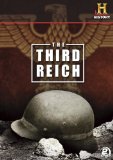The Nazis have been the subject of countless documentaries and films. On this occasion, The History Channel has decided to place the focus on the people of Germany, with a time line that starts at approximetaly the First World War and leads to the end of the Second World War. With the aid of newly discovered home videos gathered from Germany & Russia, we see a combination of German life during this time, as well as public and private views of Nazi discourse and planning.
There is one film hobbyist in particular who’s home movies become the basis for a story within the story. This one family are typical of the German people, and their lives are documented as they, like many others, go from joy, to desperation, to a sense of empowerment, to denial, to horror as their nation is seized by Hitler and his enforcers. There have been many written accounts of what the people felt and experienced, in fact many biographies are quoted and/or use as narration script in this film, but it is all the more rare to have visual records outside of propaganda films or some news reels, especially of Nazi Germany. It is such rare glimpses that makes this film so special to behold and the history of it feel all the more real.
The film does its best to not make excuses for the German people in its narrative. Their doubts are heard just as much as their support for the Nazis. Of course, as the Nazis gained their totalitarian power over the nation, few would get to the chance to object as the Nazi salute became a mandatory gesture at all events, joining the Hitler youth mandatory for all boys over 10, and not a single word of descent could be uttered on German soil without fear of interment in a concentration camp by the Gestapo.
A mentioned before, this documentary has been presented in two parts: The Rise and The Fall. The titles explain what they mean to convey rather well, and as they run along the time line of history, both parts convene then trade places at the second World War.
The editing techniques try to give a modern look to the footage being presented. A lot of scenes have the frames jostling as well as move at varying speeds the way a music video or trailer for a horror film might. Along with the grim narration and ominous quotes placed in bold letters across the film, the makers of thistwo part documentary certainly want to separate themselves from the contemplative pace of something like Ken Burns’ work. Nothing is ever too flashy thus distracting from what they mean to present. If anything, their disdain is all the more apparent and realised on film when highlighted the snuff footage they have entered into film. The snuff is meant to shock, but not in an exploitive manner. The tone is ever serious and respectful when displaying the true horrors of this time.
Video
Widescreen 1.78:1. Consisting of 100% old footage, the picture quality is quite fantastic. This footage has many expected flaws but have been restored and cared for as well as possible.
Audio
Dolby Digital Stereo. The soundtrack is full bodied and the narration is quite clear.
Special Features
None.
Final Thoughts
No matter how many different ways the Nazi history is retold, it still has the power to put knots in decent people’s stomachs. There is actual footage of murder and corpses so the film’s warnings should be listened too, it is not for sensitive viewers. Historians will truly appreciate this.





